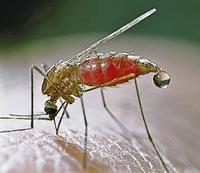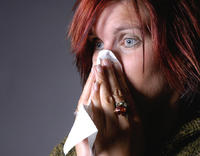-
The malaria mosquito is disappearing – researchers wonder why

The incidence of malaria in many African countries south of the Sahara is falling rapidly; a research group has discovered that the mosquito carrying the malaria parasite has practically disappeared from villages without organized mosquito control; there are several hypotheses about the cause of the decline, but without proper data researchers cannot say whether malaria is being eradicated or whether it is just resting up before returning with renewed vigor
-
-
Common bacterium stops mosquitoes from transmitting Dengue virus
Strains of a bacterium commonly found in fruit flies can prevent the Aedes aegypti mosquito from transmitting the virus that causes dengue fever, researchers have found; the discovery could lead to a more effective way to control dengue worldwide
-
-
Overcoming dangerous antibiotic-resistant bacteria
Scientists have successfully reengineered an important antibiotic to kill the deadliest antibiotic-resistant bacteria; the compound could one day be used clinically to treat patients with life-threatening and highly resistant bacterial infections
-
-
Coriander oil tackles food poisoning and drug-resistant infections
Coriander oil has been shown to be toxic to a broad range of harmful bacteria; its use in foods and in clinical agents could prevent food-borne illnesses and even treat antibiotic-resistant infections, according to the authors of a study published in the Journal of Medical Microbiology
-
-
Source of Haitian cholera outbreak identified
Employing technology that reads the entire DNA code, researchers have pinpointed the source of a cholera outbreak in Haiti that killed more than 6,000 people and sickened 300,000; the researchers also suggest how to prevent future outbreaks when international aid is rushed to disaster areas
-
-
How did H1N1 become an pandemic?

The last century has seen two major pandemics caused by the H1N1 virus — the Spanish Flu in 1918 and 2009’s Swine Flu scare, which had thousands travelling with surgical masks and clamoring for vaccination; scientists, however, did not know what distinguished the Swine Flu from ordinary influenza in pigs or seasonal outbreaks in humans, giving it the power to travel extensively and infect large populations; until now
-
-
Anthrax exposure prompts FBI investigation
Government health officials are currently investigating a case of anthrax exposure in Minnesota after tests confirmed that an individual hospitalized there had been infected with the dangerous bacteria; due to the deadly nature of anthrax and its use as a biological weapon, the FBI joined Minnesota health officials in investigating the matter
-
-
Medical silver bullet: New drug cures most viral infections

Researchers at MIT’s Lincoln Lab have developed technology that may someday cure the common cold, influenza, and other ailments; the researchers tested their drug against fifteen viruses, and found it was effective against all of them — including rhinoviruses that cause the common cold, H1N1 influenza, a stomach virus, a polio virus, dengue fever, and several other types of hemorrhagic fever
-
-
A natural food preservative kills food-borne bacteria
Salmonella and E. coli account for more than half of all food recalls in the United States; salmonella contributes to an estimated 28 percent of more than 3,000 U.S. deaths related to foodborne illness each year; researchers have discovered and received a patent for a naturally occurring lantibiotic — a peptide produced by a harmless bacteria — that could be added to food to kill harmful bacteria like salmonella, E. coli, and listeria
-
-
Innovative biosensor for rapid virus field tests
Relying on a novel DNA-based bio-chemo-physical conversion method, a new bio-detection device is able to detect harmful bacteria, such as E. coli, salmonella, and staphylococcus, on site, within thirty minutes; it can be adapted to cover such deadly viruses as SARS, H5N1 flu, and swine flu viruses; it can also be designed to monitor possible biological attack from anthrax, smallpox, cholera, and more
-
-
Gold nanoparticles help to diagnose flu in minutes
Arriving at a rapid and accurate diagnosis is critical during flu outbreaks, but until now, physicians and public health officials have had to choose between a highly accurate yet time-consuming test or a rapid but error-prone test; University of Georgia researchers offer a solution
-
-
Five Joplin survivors die of mysterious fungal infection
After being hit by a massive tornado that destroyed much of Joplin, Missouri, several residents suffered from a fungal infection that killed five people; following the 22 May twister that ravaged Joplin, many residents suffered from splinters, cuts, and other minor injuries that eventually resulted in a rare fungus infection
-
-
Research inspires robotics design for medicine, military
A pathogen that attacks the small intestines of humans and animals is serving as the inspiration for developing robots that can fight disease and aid in military operations; ror 250 years, scientists have tried to understand how the microorganism is able to attach to a multitude of surfaces and swim in harsh environments — enabling it to infect many kinds of species while most parasites have specific hosts
-
-
Anthrax vaccine program demonstrates 36 month product stability
Maryland-based PharmAthene has achieved an important program milestone in its recombinant protective antigen (rPA) anthrax vaccine program, and demonstrated thirty-six month stability of its rPA drug product candidate; the data suggest that the rPA product candidate is both highly stable and potent; stability has historically been a stumbling block for other recombinant anthrax vaccine programs
-
-
New way to attack Salmonella bacteria found
Nitric oxide is naturally produced in the nose and the gut and other tissues in the body to ward off infection; new research underscores that nitric oxide’s antimicrobial actions are due to its interference with the metabolism, or energy production, of pathogens —p and that these antimicrobial characteristics may be harnessed to inhibit the growth of Salmonella
-
- All
- Regional
- Water
- Biometrics
- Borders/Immig
- Business
- Cybersecurity
- Detection
- Disasters
- Government
- Infrastructure
- International
- Public health
- Public Safety
- Communication interoperabillity
- Emergency services
- Emergency medical services
- Fire
- First response
- IEDs
- Law Enforcement
- Law Enforcement Technology
- Military technology
- Nonlethal weapons
- Nuclear weapons
- Personal protection equipment
- Police
- Notification /alert systems
- Situational awareness
- Weapons systems
- Sci-Tech
- Sector Reports
- Surveillance
- Transportation
Advertising & Marketing: advertise@newswirepubs.com
Editorial: editor@newswirepubs.com
General: info@newswirepubs.com
2010-2011 © News Wire Publications, LLC News Wire Publications, LLC
220 Old Country Road | Suite 200 | Mineola | New York | 11501
Permissions and Policies
Editorial: editor@newswirepubs.com
General: info@newswirepubs.com
2010-2011 © News Wire Publications, LLC News Wire Publications, LLC
220 Old Country Road | Suite 200 | Mineola | New York | 11501
Permissions and Policies
